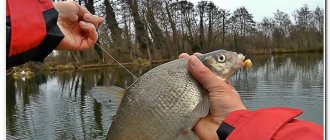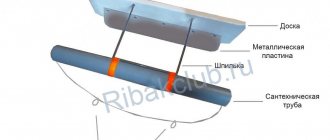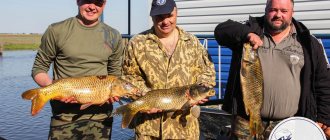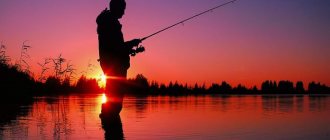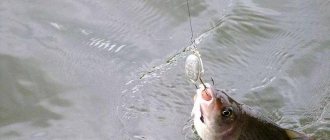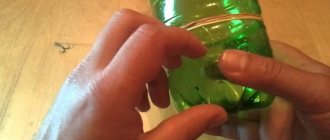Yuri 09/07/2020 940
Let's consider recommendations for catching carp in the current using feeder gear. Typically, a donka or float rod is used from the shore. With strong currents the task becomes more difficult.
Tackle for catching carp in the current is assembled according to the following recommendations:
- Feeder rod 3.5-4.2 m long.
- Each feeder tackle must have a rigid structure.
- The fishing process is made easier if you use a rigid rod with a well-bending end.
- The optimal test for the rod is 100-150 g.
- High-quality sharp hooking is achieved with a semi-fast or fast action rod.
For carp fishing, it is better to choose a feeder made of carbon fiber material - they are lightweight, have high flexibility and ductility, and can withstand repeated overloads that arise during the fishing process. Catching carp in the current is made easier with a three-piece plug rod, where you can change the quiver tip in accordance with different types of action.
How to catch carp on the Volga with a feeder - from gear to fishing
Carp is not only a beautiful, tasty and large fish. As previously written, this is a very careful, strong and fast fish. It is possible to catch it with a regular float rod, but it is very difficult and, most likely, your line will break for several reasons. More and more often, experienced fishermen use a feeder or an English donka to catch carp. In this article you will learn about the features of catching carp on a feeder specifically on the Volga: you will get acquainted with the carp fishing technique, feeder equipment, and other features.
In the bay
If the surf was hitting our shore frontally, then on the left flank, in military parlance, we could see a quiet bay with thickets of water lilies and, obviously, deep places. This was evident when I went out into the bay on our emergency boat. Along the edge of the grass there was a black depth. But it was impossible to fish from a boat. The “pumping” didn’t last long and even one couldn’t fish calmly. Soon the sides of the boat shrank and the bench collapsed under me. Inflating the boat on the floor with a hand pump was inconvenient.
For some time we caught rudd and roach from the shore using float rods, throwing a hook with maggots into the windows among the water lilies. The float did not remain motionless for long. Soon he swam to the side, going into the depths, and a golden fish with scarlet fins was fighting on the line. Rudd... Soon we caught various fish on our fish: rudd, magpie, perch, and silver bream. There were only bream missing in the grass, not to mention bream.
After lunch, with another glass and a fragrant fish soup from fresh fish, my thoughts somehow cleared up, and some kind of impatient excitement appeared, as if after some despondency some internal engine had turned on. It was decided to look for a place for feeders along our coast, looking at the open Volga, especially since the wind died down a little and the surf became weaker.
Necessary gear
After catfish, carp is second on the list of the most attractive fish for those who come to fish on the Volga. The process of catching fish will give you great pleasure, so the gear must be strong and reliable.
Budget carp reel Daiwa Black Widow with increased strength
Best option:
- Feeder rod Team Salmo ENERGY Feeder, length 3.9, test 120-250 g
- Daiwa Black Widow carp reel from our rating of the best Daiwa spinning reels.
- Salmo monofilament line, Feeder series. Thickness 0.3-0.4 depending on the expected trophy.
- Carp hooks Owner.
A few details about the choice
Feeder rod. Many fishermen, and some of them are experienced ones, make the same mistake - they choose the same feeder rod for different fishing conditions. When choosing gear, you should take into account the natural conditions in which you will be fishing and the fish you want to catch.
If we talk about fishing for carp on the Volga in the lower and middle reaches, at medium and long distances, then the feeder rod should be of the medium, heavy or super-heavy power class and at least 3.9 meters long. Very rarely, in places with weak currents, at short distances a short rod (2.7 - 3.3 m) of a light power class will be more effective.
Coil. When choosing a reel, pay attention first of all to the spool diameter and gear ratio. These indicators should be quite high. They will provide you with quick unwinding of the gear. In general, for fishing on such a fast river as the Volga, experienced fishermen use a free-running reel. The functions of the reel will allow you to rewind a little fishing line, which will go under the water, forming an arc, which will prevent the load from being torn off from the bottom by the force of the current.
Fishing line. Here the opinion of fishermen is divided:
- Some people prefer wicker. It does not stretch, bites are very clearly visible. Prevents the fish from going into snags. But the disadvantage is that it rubs against stones and snags. Although we recommend fishing lines with a high-class hardening coating, for example Salmo Elite Braid 0.2-0.24 .
- Another part of the fishermen prefers high-quality monofilament fishing line - it stretches a little, which makes it possible to additionally dampen the jerks of strong carp. Less rubbing on stones. The disadvantage is that it is a little thicker and stiffer, which affects the casting distance. Also, it still stretches, which requires the fisherman to fish with constant retreat back along the shore in order to prevent the carp from going into the snags. We recommend Salmo Specialist Feeder 0.3-0.4 mm
.
Replaceable tip (quivertip). Here you also need to take into account the natural features of fishing. For fishing in strong currents, it is necessary to install rigid tips. However, there shouldn’t be any problems with this; any feeder or carp rod, even a budget class one, has interchangeable tips.
A shock leader is a piece of monofilament, 6-10 m long, tied to the main fishing line. It is used when they want to avoid shooting equipment when using heavy loads and feeders. The correct knot for a shock leader is described here.
Leadcore is another important component of carp equipment, especially important when fishing on stones or snags. Leadcore will prevent the fishing line from rubbing on the stones and will submerge the equipment so as not to arouse suspicion in the carp of the presence of foreign bodies in the form of a stretched fishing line.
Choosing a place and fishing technique
The permanent stopping and feeding areas of this fish are most often located far from the coastal zone. Therefore, catching carp on the Volga in the current with a feeder solves this problem. Schools of carp are located in deep-sea backwaters at the junction of currents, choose hard sandy soils, and feed in nearby thickets of underwater vegetation.
It is worth throwing the tackle every 15 minutes if there is no bite. The initial feeding attracts small fish, and only after a few hours should we expect the carp to approach. The intensity of biting small fish will noticeably decrease; here you should pause and wait for a bite of a real trophy.
Some fishermen do not fish from the shore, but believe that fishing for carp from a boat in the current is the only opportunity to catch a large trophy. However, if you follow the “Fisherman’s Calendar”, which was compiled by experienced fishermen of the Sazanya Bukhta base, then finding trophy specimens will not be difficult.
TAGS:
Feeder rigs for fishing in the current
Carp is a wild carp and lives in running water.
Here it is impossible to feed with boilies, as we did when fishing for carp in still water. We will stick to the feeder type of fishing, but with elements of carp equipment. List of feeder rigs that are well suited for current:
The most popular equipment for feeder fishing in the current is a helicopter and two knots, but in this case it is not very suitable due to the very passive and wait-and-see type of fishing, as well as the use of heavy baits (for example, boilies). You can try, but you should understand that this equipment is good for strong currents and bait floating above the surface of the bottom (the bait for this should be light).
We will choose an asymmetrical loop or paternoster. The first is good for self-hooking fish and further trouble-free fishing, the second is very sensitive and will show the slightest touch of the carp, you will have to hook when a significant stretch of 10 cm appears.
Loop feeder rigs for catching carp on Akhtuba
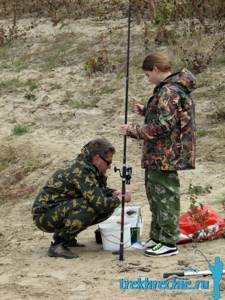
These are the most commonly used types of equipment for feeder fishing. They are quite simple to make and very informative and sensitive to bites. In Trekhrechye on the Lower Volga, with such gear you can catch almost any peaceful fish, including carp, crucian carp or bream, which are desired by the heart of any angler.
Feeder equipment is divided into “blind” , sliding (in-line) and loop . Loop feeder equipment, in turn, can be symmetrical or asymmetrical
and, as a special case, a “ paternoster ” type rig (named after the inventor), which, unlike the previous two, is knitted directly on the main line. But when fishing in the current and the presence of snags, driftwood, etc. at the bottom, it makes sense to use a 0.22-0.25 mm braided cord as the main fishing line, and a less durable rig with a feeder will help maintain the full length of the expensive cord when dead toe. Therefore, we will take a closer look at the first two options, in which the loop equipment is knitted separately and in the event of a break, it can be quickly replaced with the one in stock.
At its core, loop feeder equipment consists of a loop itself, along one side of which a
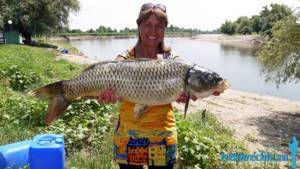
a sinker-feeder, and a leash with a hook attached to the loop through a twist made from the line of the loop itself. This design allows you to move the leash away from the feeder and prevent twisting and tangling when casting. As is clear from the name, in a rig with a symmetrical loop, both sides of the loop are equal, but in an asymmetrical rig, one arm on which the feeder sinker slides is longer. There is an opinion that feeder tackle with an asymmetrical loop is much more sensitive than a symmetrical one. This is due to the fact that a shorter section of the loop leading to the leash more clearly transmits the bite to the rod, and at the same time, the feeder sliding along the long section does not provide resistance to the fish at the first moment. Be that as it may, for fishing in the current, it is the asymmetrical loop that turns out to be more catchy, that is, it gives fewer trips and empty bites.
Elements used for the manufacture of loop feeder equipment:
- fishing line for the loop;
- sinker-feeder;
- leash with hook;
— fasteners with swivels;
— additional baits or micro-floats on the leash line to sink or raise the bait above the bottom.

As already mentioned, unlike the “paternoster”, loop equipment can be made in advance and laid on a reel. The final assembly of the gear occurs immediately before casting and includes selecting a feeder of a certain weight, attaching a leash with a hook to the loop and attaching all the equipment to the main line (cord).
For installation of loop-type feeder equipment, only monofilament fishing line with a diameter of 0.20 to 0.28 mm, depending on the load and clogging of the bottom, is used. The color of the fishing line for the loop, depending on the fishing conditions, can be transparent (during the day in clear water), brown (during the day in muddy water) or even black (when fishing at night and in the twilight). The line for the loop should not be too stiff or thick. Hooks for such gear are selected, as in the case of fishing with any type of donkey, depending on the size of the intended catch and the type of bait. The leashes should be extremely thin, invisible to the cautious carp or crucian carp. There is no need to remind about the sharpness of the hooks, since the feeder, like other donkeys with a sliding sinker, is a self-hooking tackle, where the weight of the sinker drives the hook into its lip during the first jerk of the fish.
An important point in the manufacture of all types of loop rigs is the careful trimming “flush” of the ends of the fishing line that protrude after tying knots, to which thin leashes can constantly cling. For these purposes, you can also use thin silicone casings of a suitable size, which are placed on the tackle units.
Installation of feeder equipment with a symmetrical loop

This type of equipment is the simplest and fastest to install. At the same time, it is convenient, fixes well on the bottom and is quite sensitive to bites when fishing with a feeder in still water or in backwaters where there is practically no current. When fishing in areas with current, its sensitivity decreases and, as a result, the number of empty bites increases.
A symmetrical loop is mounted as follows:
1. From a piece of monofilament fishing line 1.0-1.5 meters long, make a loop with one end 15-20 cm longer. On the fold we make a loop for attaching the leash;
2. after the leash loop, use the free ends of the fishing line to make a twist 9-10 cm long and fix its end with a surgical knot (the twist should be smooth, straight, with symmetrical angles to the fishing line);
3. 30 cm after the end of the twist we make the final surgical knot, which forms a loop on the fishing line with equal sides between the knots;
4. We cut the short end of the line remaining behind the knot as short as possible, and on the long end we tie a swivel after 10 cm to attach the equipment to the main line - it will help to avoid unnecessary twisting of the main line when casting and retrieving the tackle.
The sinker-feeder is attached to either side of the loop on a swivel with a clasp, which eliminates twisting of the fishing line and allows you to quickly replace the feeder when selecting the correct weight of the tackle. To do this, it makes sense to place the swivel immediately on one side of the loop before knitting the closing knot. The leash is attached using a loop-to-loop method, which is not difficult for a novice fisherman.
Installation of feeder equipment with an asymmetric loop

Also not difficult to manufacture and more sensitive, especially when fishing in the current, the feeder equipment is mounted in a similar way with the difference that one of the sides of the loop on which the feeder is attached is made 10-15 cm longer. Therefore, when tying a loop you should:
step back the same 30 cm from the knot fixing the end of the twist and extend one of the sides by about another 10 cm, then complete the loop with a surgical knot and attach after it, after 10 cm, as in the previous case, a swivel for the main fishing line.
To reduce the number of overlaps between the leash and the loop when casting, you can also make a twist 8-10 cm long on the base of the leash.
Thanks to this asymmetrical position of the feeder-weight relative to the loop, the leash will always be directed towards the main fishing line, and this significantly increases the sensitivity of the gear to even the slightest vibrations of the bait when it moves in any direction. In addition, when casting the tackle, the load flies in front, stretching the loop and moving the leash to the side, which reduces the possibility of entanglement to zero.
And of course, it is important that the feeder sinker slides along the loop as easily as possible.
More
Groundbait and feeder feeding techniques
Feeder bait is either made independently or purchased in stores.
We have already written a detailed guide about mixtures and techniques for feeding carp. We recommend combining homemade bait with store-bought bait for two reasons:
- Store-bought bait contains very active flavoring additives, which will attract carp downstream from distant sites. Also, many professional baits from the Trapper and Dunaev series contain bite activators, which help improve the digestion of wild carp.
- Homemade bait, in turn, is nutritious and rich in natural carbohydrates and proteins. Having tried this bait, the carp will not refuse the table and will continue to feed for a long time.
Be sure to add an animal component to the bait. In cold water it is 1/3 of the total bait, in warm water in the summer it is 1/10 or 1/15 of the total bait. If you try for a worm, then feed it with chopped worms. The vegetable component of the bait should also be in the bait - corn, green peas, pearl barley, boilies.
Optional Popular Supplements
In the southern regions of the Volga, carp are fed with the inclusion of shell meat in the bait. To do this, take out the pulp, chop it finely, and add shell shells.
You can make bait based on semolina. Take sunflower cake, mix with breadcrumbs, mixed feed, semolina and lightly steamed oatmeal.
When fishing in medium and fast currents, wheat bran is added to the bait (preferably unevenly ground). By dissolving in water, particles of such bait will create turbidity, which is attractive to carp. Wheat bran is steamed for a long time over low heat.
Feeder feeding technique
Open feeder
- Here is what the sequence of your actions should be:
- Leave only the open-type feeder on the rig; do not attach the leash with the hook yet.
- Fill the feeder with bait, compacting it a little on the sides, but not too much, so that when you reach the bottom and jerk with the rod, the bait can wash out to the bottom.
- Make a cast with 80-90% strength and based on a landmark on the opposite bank (a tree, a house, but not a cloud or a car, which can move over time).
- As soon as the feeder falls into the water, close the line handle and place the feeder rod on the stand. After this, the line will be stretched for some time, and the feeder will continue to fall to the bottom.
- Clip the line into the special clip on your spool. It usually has the shape of a regular triangle with soft edges. After this, when casting with 100% of your strength, you will always hit the same place along the length of the line. All that remains is to aim at the landmark on the opposite bank.
- After the feeder falls to the bottom, the line will sag and the tip will weaken. We wait 5-10 seconds and make a strong jerk so that the food is washed out of the feeder. Then we take the feeder out of the water and repeat the entire procedure 10-15 times.
Fishing on the middle Volga
Fishing on the middle Volga differs little from region to region, but there are still some differences. We will indicate fishing spots in each region and methods of fishing in winter and open water.
Fishing in the Nizhny Novgorod region
The general situation of fishing in the Nizhny Novgorod region has been deteriorating recently. Fish are leaving water bodies, and new bans on fishing for certain sizes of fish are being introduced. However, fishing is still possible.
The main fishing places in the Nizhny Novgorod region, in addition to the obvious ones within the city, are:
- The Gorky Sea is a wide part of the Volga, upstream from Nizhny Novgorod. They are caught mainly on the left bank. Sokolskoye and other settlements along the route.
- The village of Velikovskoye and the nearest places downstream. In this section the Volga is expanding again. This place has frequent bends and a higher chance of catching trophy roach or pike.
- Near Dzerzhinsk - at the mouth of the Oka, on both sides.

A tributary of the Volga is the Oka, one of the popular catching places is Dudenevo. In this pool you can find Oka sterlet.
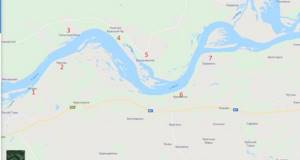
Fishing spots are marked with numbers, downstream from Nizhny Novgorod
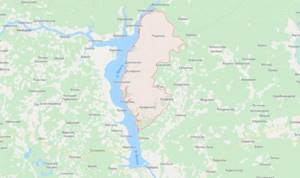
Roach, pike, perch These places are rich in sharp changes, edges, snags and greenery, which both predatory and ordinary fish love so much.
What are they fishing for?
Catchless reelers
In open water in spring, summer and autumn they fish with:
- Spinning. Jig rigs, microjig - rubber, technoplankton. Wobblers up to 5 centimeters. They catch pike with spinners, perch with balancers, and crucian carp with jigs.
- Float. Ide up to 500 grams, small pike up to 1.2 kg, dace, bream.
- Feeder gear, donks . Mainly roach and crucian carp . Feeders are used with a load of 80 grams, provided that the fishing takes place on the Volga. The best performance is shown by the non-sports tackle crucian carp killer . Fishing with donkeys and feeder from a boat is possible. With some luck, you can catch catfish, bream, and pike perch.
- Twitching when fishing from a boat. It is practiced less and less.
In winter.
Mainly caught
They are caught using jigs, reelless baits, and micro jigs. Less often on small balancers and spoons (spinners and spoons, one of the most catchy models is Mepps). Pike up to 1.6 kg are caught using bait baits. Install up to 10 vents simultaneously. At the same time, you can catch perches using nodding rods with 3-5 centimeter balancers.
Fishing in Cheboksary
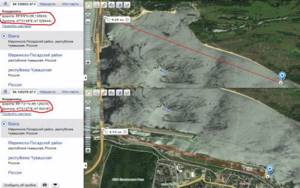
Click to enlarge Let's start with the ban . Under certain conditions, fishing near hydroelectric power stations is prohibited in the following cases:
- Closer than 500 meters from the dam upstream (towards the city);
- Downstream 4 kilometers, downstream.
Fishing conditions:
- The maximum number of hooks per one tackle is 2 pcs.
- The maximum number of simultaneously used baits with single hooks is 2 pieces.
- Ban on fishing for any sturgeon.
- Prohibition on fishing from swimming devices (any kind).
- Fishing from the shore and winter fishing on ice is allowed.
Where and how do they fish on the Volga in the Cheboksary region?
Within the city limits they catch:
- On the bay . Often small specimens of crucian carp, crucian carp, and perch are caught. Recently, after the construction of a new bridge began, fish from the lower bay have practically disappeared. In the upper bay they fish with spinning rods and float rods. They can fish with spinning rods right up to the freeze-up. During the first ice they catch with jigs (devils) and a reelless bait. You can try to fish with miniature balancers.
- At the river port . You can catch bersh, crucian carp, perch, and sorozhka. Sometimes a small bream may swim in.
- Near the beaches . On the Volga from the shore in open water they fish with feeders, placing 2-3 rods at once. The feeder load starts from 60 grams, the rod is taken with dough from 80 grams. The current on the edges is slower than on the surface. Don't forget to take into account the weight of the complementary foods in the feeder. Spinning is practiced, but less frequently. You can catch bersh, perch, rudd, bleak, and silver bream.
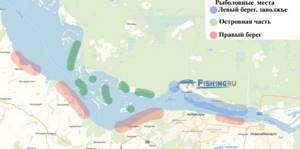
Outside the city.
- Islands . There are many boat stations in Cheboksary, which indicates the popularity of fishing from boats. They usually fish from boats using heavily loaded feeders and donks. Molasses and garlic juice are added to the bait. They catch pike perch, catfish, pike, bream, pike perch, asp, and ide. Twitching is possible, but usually fishing occurs in the water column. In winter they catch using: balancers, jigs, jigs, small spoons, baits. Pike up to 1.8 kg are caught with small spoons, and pike perch with balancers and rattlins. Pike is caught using girders or rigs with sprat. 4-5 are installed at the same time.
- Left bank, Sosnovka, Trans-Volga region . Also feeder, donks, spinning rod with wobblers and jig (silicone) baits. They catch fish with maggots on a float, but as a rule it is sluggish and practically ineffective.
- Right bank.
Near the beaches, crucian carp, perch, bream and bersh are usually caught.
carp is a crucian killer and an easy feeder, and bersh is more likely a by-product.
Watch a video on winter fishing in Ilyinka, Chuvashia.
Kazan

Fishing spots within the city .
Millennium Bridge . Opens early. They have been fishing with spinning rods since April. Spinning anglers mainly catch pike perch, not counting small fish. They catch it with jigs and wobblers. Sometimes large perch are caught. Fishing is practiced under the bridge.
Chasha Wedding Palace .
The shore opposite the bowl. They catch it with a spinning rod and a float. They fish on the feeder at the red mark (picture on the right, click to enlarge). Carp up to 2 kg are sometimes caught on the feeder. They catch bream, pike perch, perch, and crucian carp. Leninsky Bridge near the Kremlin .
Slight current. They don't practice feeder here, there are too many hooks. They fish with a float and a spinning rod; flat floats are used. They catch bream, roach, perch, small fish. They catch all the way to the Kirov dam. Near the Parus restaurant . Previously, the shore consisted of concrete slabs, which made it easy to get close to the water. Now there is a sharp concrete wall. They fish with a feeder, a float, or a spinning rod. In the spring they catch it with jigs, rubber, and wobblers. In summer, more and more on the float. When going to this place, don’t forget your landing net - there’s nothing to do there without it.
Fishing directly on the Volga.
They fish on the right bank (on the map - on the left).
from the shore from Verkhniy Uslon, right up to the village of Tetyushi.
Pike perch, carp (up to 3.5 kg), bream, pike perch, rudd, chub, perch. All gear is used: jig, wobblers on a spinning rod, perch is caught on a retractable leash. Feeder gear with feeders from 60 grams, feed abundantly. Float fishing is effective for maggots and regular worms.
Feeder fishing from spring to October.
fish with spinning rods and floats right up to the freeze-up.
In winter , the main trophy is pike perch, which is caught using a hook and spoon. The pike bites on girders and stands with sprat. With winter fishing rods you can catch pike using a spoon. Bream, perch, and bersh (mostly medium-sized) bite on balancers and jigs, and predators on baits with sprat.
From boats they fish with donkeys, catch bream and pike perch up to 4 kg.
Ulyanovsk region
Within the city limits they are caught in three places, on both sides of the bays.
Between two bridges. From the upper bridge to Polivno. From the lower bridge to the clinical hospital (picture on the right). It’s impossible to catch large fish within the city, but you can still catch some.
Mostly perch bite between the bridges. They catch pike perch, perch, ruffe, and small bream using spinning rods.
From a boat they hunt mainly for bream, mainly with a ring or bottom gear.
In winter, perch bite on balance beams - specimens up to 20 centimeters are caught. Pike and pike perch are caught using sprat using classic girders or homemade baits. You can catch small ruffs with small castmasters (3-4).
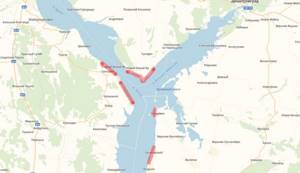
Fishing places down the Volga
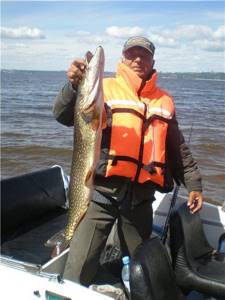
Fisherman's report from the Kuibyshev Reservoir, large pike
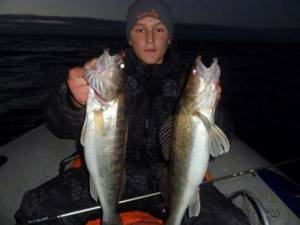
Fishing reports from the site fishing73
Outside the city.
Fishing occurs both above the city - in the Kuibyshev Reservoir, and below
- They bite crucian carp up to 900 grams, pike perch up to 3.5 kg, pike up to 5 kg, bream up to 3 kg. At night you can catch pike perch up to 7 kg.
- From the shore and boats, pike perch bite well on vibrating tails and other silicone in natural colors. The load of gear is up to 20-25 grams, the current does not require more.
- Pike also actively bite on vibrating tails when the heat subsides.
- Using a feeder from the shore you can catch large carp and bream, up to 5 kg. Carp are also caught using carp gear.
Fish in the Ulyanovsk region on the Volga are unpretentious, so even store-bought bait from the same Dunaev or others will do.
Fishing in Samara
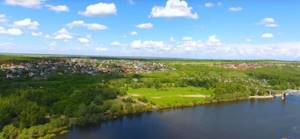
Who can be caught in the Samara region:
- Carp,
- Bream,
- Tench,
- Rudd,
- Carp,
- Gustera,
- Perch,
- Pike,
- Zander,
- Bersh,
- Ide,
- Soroga,
- Chebak.
Recently, asp has become significantly less numerous.
Fishing in Samara on the Volga takes place on both banks. We will not divide into fishing within the city, we will indicate the main places and methods of fishing.
- Usa River, Usinsky Bay . Productive fishing in the summer, pike perch biting on spinning rods, bream on bottom. Carp, pike, roach, silver bream, ide. Drive along the M-5 highway to Mezhdurechensk or Pecherskie Vyselki
- Left Coast. Above the city they are caught on the left bank, along the Krasnoglisk highway . Studio ravine, Volzhsky, behind-the-scenes. (few large specimens, mainly bream and perch. Preferred baits are rubber and jig. The feeder is ineffective.
- Vasilyevsky Islands are difficult to get to, but fishing from a boat in open water, and in winter from ice, will not keep you waiting long. Between and near the islands you can catch bream and silver bream using a ring, pike perch too, and in winter using a snooker.
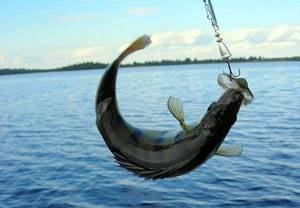
Saratov
The Saratov region extends for many kilometers, including kilometers along the Volga. There are many promising places in the region itself, both to the south of the city and to the north.
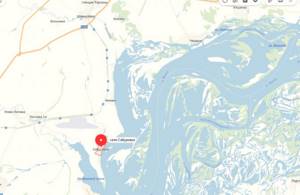
Saburovka and Kozlovka are good places near the city itself. In addition to crucian carp and perch, you can catch the sorozhka using a spinning rod
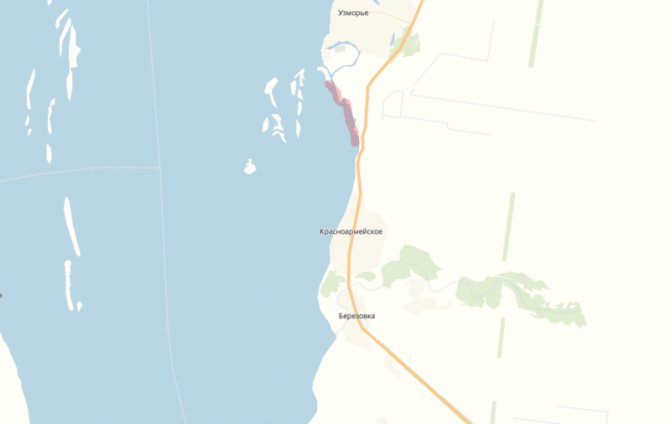
Krasnoarmeyskoye is a place with numerous holes and quite large pike, bream, roach, sitting at a depth of 3 meters
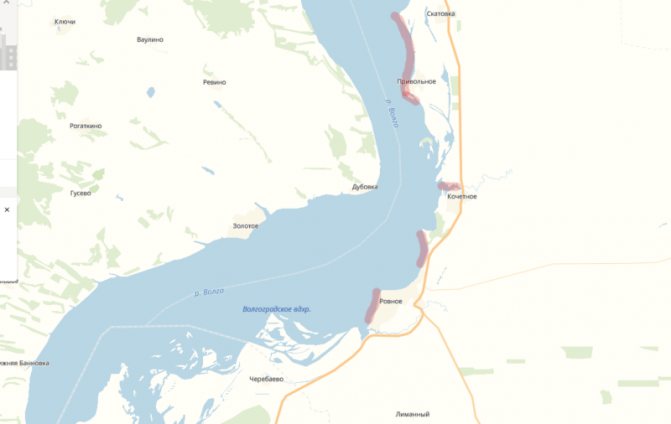
Cool fishing spots on the east side, down from Engels
From the shore.
- On the west side to the north . Ust-Kurdyum, Saburovka, Kozlovka, Vyazovka, Chardym. There are many sharp changes in depth, many edges. Pike are excellently caught using a spinning rod and a feeder with a dough of 80 grams or more (for long casts). For some reason, they are best caught in these places using medium and large balancers of green and yellow colors. Medium pike up to 3 kg also go well with jig rubber. In addition to pike, they bite: sorozhka, bream, bersh, rotan, crucian carp, perch. For crucian carp and perch, a float, a spinning rod with flies or small rubber is enough, but for bream and roach you will need a medium test feeder, because the current is not strong.
- Along the east side to the south . Fishing starts from Privolzhskoe itself, further down the highway, all the way to the Volgograd reservoir. The final point for fishing from the shore will be the village of Rovnoye. Mainly fishing with a spinning rod, because it is universal in catching most fish. The baits used are both jigs and wobblers from 3 to 6 centimeters, brightly colored.
From the boat. It is much easier to catch all the richest places in the Saratov region with a regular motor boat with a motor of 3 hp or more. Besides the obvious islands, the following are popular:
- Volozhka Bereznyakovskaya,
- Volozhka Koshelevskaya,
- Elshanka.
- Place near Ust-Kurdyum.
In these places you can catch particularly large pike (up to 7 kg) using wobblers. Pike perch up to 6 kg on wobblers and jig baits. Don't forget the landing net!
Winter fishing.
Winter fishing in Saratov is not limited only to jig fishing for devils, but pike perch are also quite successfully caught using clicking lures, pike using sprat (with girders and hooks). It is rational and appropriate to use small rotators and oscillators, as well as castmasters. In addition to the main target of anglers - pike and pike-perch, rotan, perch, roach, and brushfish are successfully caught. The bait comes with classic bloodworms, which is quite enough.
Video report on winter fishing in Saratov:
Lures and lures for carp
Boyle on a hair rig
Boilies are an excellent bait for carp due to their size, choice of flavoring and aromatic properties and color.
Depending on the activity of the carp and the frequency of bites of small fish, it is customary to use the following attachments:
- In autumn, when fish activity is low, use one sinking boilie with a diameter of 18 mm on a hook.
- In summer - 1-2 boilies with a diameter of 24 mm.
- Fishmeal boilies work better in the summer, when the water begins to warm up and shellfish multiply.
- It happens that the carp experiences mood changes during the day. So, in the second half, with the onset of heat, experienced fishermen recommend replacing fruit boilies with fish ones.
- In strong currents, flavors are quickly washed out. Therefore, it is necessary to soak the nozzles in them for at least 2–3 hours.
Spring and autumn baits:
- bunch of worms
- barley shell meat
- bunch of maggots
Summer:
Choose sections of the river with whirlpools and return lines

Firstly, whirlpools are created due to unevenness at the bottom, and there is a high probability of edges and falls.
Secondly, in such places the current is weaker, which is convenient for both you and the fish, which does not want to waste extra energy fighting the river current.
Fishing technique
We have already talked about bait - this is the first stage of fishing, which should be repeated after 2-3 hours, especially if the bite has stopped.
After feeding, attach a leash with a hook to a hair rig with a boilie. We described how to make a hair rig in the carp guide to bottom fishing.
Throw out the rig and wait for the bite. The frequency between re-casting the tackle during active biting should be no more than 10 minutes. In the fall, when the carp becomes passive, you can transfer it every 20 minutes, while, of course, filling the feeder with new food.
Start with classic baits, gradually moving to more conservative ones. For example, if you don’t bite fruit boilies, try boilies made from fishmeal. If you don’t bite on light-colored boilies, try replacing them with light ones. If you don’t bite on sinking boilies, try Pop-up boilies (floating boilies that will be 3-4 cm above the bottom).
In the end, you can try mixing animal ingredients into the bait. But you need to change the place only after 3-4 unsuccessful catches, not earlier.
Fishing. First, adjust the drag so that the line leaves the reel with maximum resistance. And in snagged places, the use of a friction clutch is generally fraught with the loss of fish and equipment. Your tackle should be as strong as possible and withstand the jerks of the carp. Secondly, you should not force events. Fish slowly, don’t let the carp go far, but don’t pull it with all your might. You'll tear your lip or rig. You should only bring it to the shore when the fish stops making sudden jerks.
Bait for catching bream on a feeder
When catching bream on a feeder, bait can be prepared in two ways - buy it in a store marked “feeder” and “bream” or make it yourself.
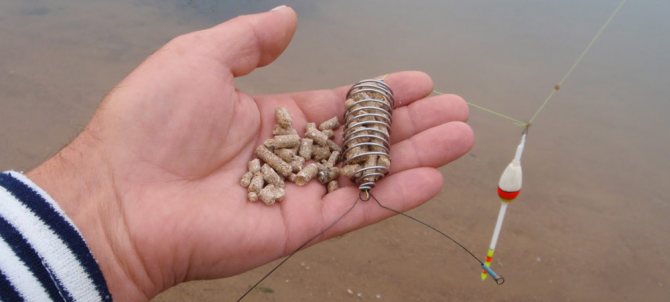
Let's consider the first option of bait for bream, since the second one requires a whole article. The seller may offer several types, with different properties. In addition to the bait itself, he will definitely try to impose a flavor on you. You need to be careful with these miraculous “goodies”. The fact is that in cold water they may not attract fish, but on the contrary, scare them away. In summer it's a different matter.
If you nevertheless decide to take a flavoring, then know that in late spring on a feeder on the river, as well as in the summer, this fish responds very well to such aromas as dill, anise or vanilla. As for “sweet aromas,” bream loves caramel, biscuit or strawberries.
The main rule is that the bait for bream at the bottom should not remain inside the feeder all the time, or not be washed out immediately, within a couple of minutes. There must be something in between. That’s why fishermen advise – don’t over-moisten it while kneading.
Let's sum it up
- Use reliable gear, our recommendation:
- Feeder rod Team Salmo ENERGY Feeder, length 3.9, test 120-250 g
- Daiwa Black Widow carp reel from our rating of the best Daiwa spinning reels.
- Mono line from Salmo, Feeder series. Thickness 0.3-0.4 depending on the expected trophy.
- Carp hooks Owner.
- If possible, explore the carp's site in advance. If this is not possible, ask local fishermen. The appearance of splashes at dawn is a clear sign of the carp’s stop.
- In summer, to catch carp, use plant baits, and in spring – animals.
- When fishing in the current, feed the carp at regular intervals. In standing water, make one generous feeding.
- For beginners, we advise you to start with a paternoster feeder rig; for more advanced ones, an asymmetrical loop or helicopter and two knots are suitable for fishing with light baits.
- Fishing with a feeder is physically difficult work, since the rod is powerful and you have to cast far and often.
Please be patient and pay attention to each item on this page. Be sure to write about your experience here, it will be interesting to us and other anglers.
Fishing with Feeder on the Volga
In the mornings the Volga resembles a large lake. There is almost no current, and stripes of greenery stretch along the banks. The shutters of hydroelectric power stations usually open around ten o'clock. Only then can you start the engine and go to your proven places. Such places are mostly located on the high right bank of the Volga near the village of Kokshaysk, where the depth is greater and the current is stronger. There you need heavy gear and powerful anchors. Donka-“ring” with a kilogram of lead in the feeder is the most popular tackle. Large ides and bream stay here and from time to time make themselves known with sharp bites and the ringing of a bell at the guardhouse of the side bottom. But all this is possible when the current is given. Early in the morning, if you can’t sleep, all you can do is admire the beauty of nature.
I always have a spinning rod and feeder in stock. Any fishing is unpredictable: sometimes there’s no bite, sometimes a predator or another fish takes you that you didn’t expect. Fishing happens in different ways, and it’s better to have different gear.
Also with bait. If, in the old fashioned way, I fill a “ring” bucket feeder with home-made bait, more often with a mixture of porridge, steamed peas and flavorings, then feeder feeders on light side bottoms are filled with bait for the feeder. Although fishing is done from a boat, feeders and food are what you need for fishing at shallow depths and at the mouths of rivers flowing into the Volga. Therefore, a couple of bags of complementary foods are always at hand.
Feeder equipment for bream
In the minds of many, especially spinning anglers, a fan of feeder fishing is a fisherman with a fishing rod and a chair. However, if you take a closer look, a real feederist’s kit includes a lot of other fishing gear, most of which are selected for a particular fishing activity.
Let's take a closer look at the rigging of a bream feeder.
Rod. So, the best choice for this type of fishing is a carbon fiber rod with a cast weight of up to 120-180 grams (depending on the strength of the current and casting distance). According to some reports, bream is a deep-sea river fish, which means that for successful fishing you will most likely have to make long casts.
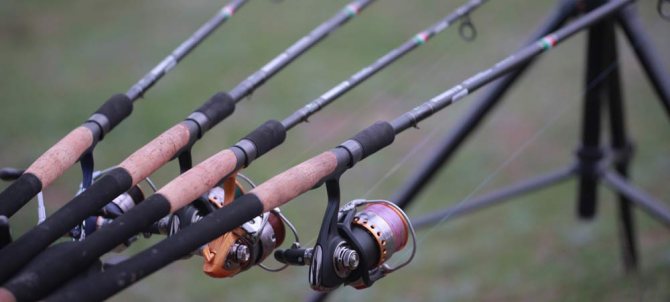
Experienced anglers can use fast action blanks, but for beginners the slow action is ideal. This is explained by the technique of throwing heavy feeders over a long distance. As for the length, the optimal option is considered to be 3.6-4.2 meters.
Coil. Most often - inertia-free, with metal bearings in the amount of at least five pieces.
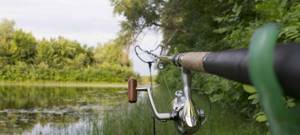
fishing on the feeder» />
The choice of spool is either straight or tapered. If you have to throw a load far, then its sides should be low. Size from 4000 to 6000. The weight of the coil should be about 400-500 grams. The clutch can be used both rear and front - whichever is more convenient for you. Gear ratio 4.5:1 - 5:1.
Cord or fishing line. Both monofilament line and braided cord can be wound onto the spool of the feeder reel. The thickness of both the first and second options depends on the fishing conditions.
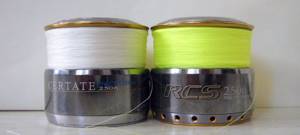
If you have chosen a river as your fishing spot, then it is better to choose a braided line, which will float less in the water column. In this case, the optimal thickness is 0.12. This diameter has a breaking load of at least 5 kg, which is more than enough when catching bream on a feeder. The thinner the diameter of the main line, the lower its windage and the more accurately bites can be read.
Feeder. For most feeders, the feeder is a consumable item. Therefore, there should always be several pieces in stock with different weights, shapes and volumes of loaded bait.
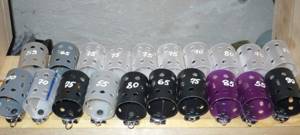
For an average river flow, the initial weight of the feeder can be considered 40-60 grams, optimal 60-100 grams.
Leash. It must be made from monofilament, the length is at least 50 cm, and the cross-section is about 0.12-0.16 mm. If the water is crystal clear, then the cross-section can be reduced, but do not forget - this will increase the possibility of a break.
Hook. When catching bream on a feeder on a river in summer, most athletes advise using small hooks. The fact is that they are easier to disguise with bait, which means that the bream is more willing to swallow it and get hooked.

However, do not forget that a small hook can easily jump out of the mouth of a large bream during hooking. It is important to understand that there is no middle ground, but there are some recommendations that depend on the nozzle.
- Bloodworm. Optimal size No. 18-16;
- Maggot. This attachment can be used either one or several per hook. The size in this case is No. 14-10;
- Corn. With this type of bait, the optimal hook is No. 14-8;
- Worm. It is important here that the fore-end is of medium or long size: No. 10-8.
Catching Bream on a Feeder on the Volga Video
Fishing for bream on a feeder in May
In fact, one of the favorite fishing trips among amateurs is fishing for bream on a feeder in May . There is an option to catch bream both in a standing water zone and not in rivers, or in other words, in artificial lakes. Our client’s favorite feeder remains more and more popular, and catching bream at this location remains less and less interesting for our client.
Catching bream in May on a feeder
The greatest body length is 82 cm, weight is 6 kg, the longest life expectancy is 23 years.
Bream stay in groups, mostly in the deepest places overgrown with plants. Cautious is not smart enough.
The convex shape of the mouth is perfect for searching for food in soft mud. The larvae feed on zooplankton. Upon reaching a length of 30 mm, the fry switch to feeding on benthos. It feeds on insect larvae, tubifex worms, shells and snails. It can also eat aquatic plants.
Bream can gather in huge schools, especially in large lakes or, in other words, in strong currents. Such packs clean out sections of the bottom of reservoirs without leaving a trace and move on, not very briskly, leaving cleared “roads” behind them. Such movements are easy to see by the floating bubbles of swamp gas, which are released when a school of bream “turns over” another section of the bottom.
Bream reaches sexual maturity at the age of 3 to 4 years. Spawning always occurs on grassy shallows, in shallow bays, and does not occur with a loud splash. At that time, the male develops countless small blunt-conical tubercles on his body, initially snow-white, later amber-yellow in color. Spawning time in central and northern Russia is no earlier than the first days of May, in the south from mid-April. The movement of bream to the Volga from the seashore begins in February under the ice, and the full movement occurs around mid-April. Fertility is from 92 to 338 thousand eggs. The temperature required for spawning is about 21 degrees.
During spawning, males form areas on the pages of which females spawn. The fry hatch after 3 to 12 days and are not attached to aquatic vegetation with a special secretion. They remain attached until the yolk is completely used.
Large bream on the river. Video
Published: March 13, 2019
An educational video from Alexey Fadeev about river bream fishing on a feeder. In it, Alexey spoke clearly about bait, equipment, feeding tactics and fishing techniques.
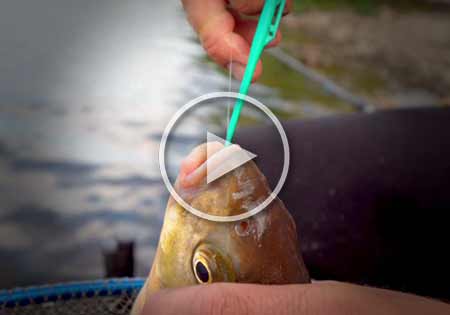
Fishing place: Volga River opposite Cheboksary. The situation is standard for many feeders: a strong current, high-quality bait and bait available, a promising edge is not difficult to find, but the fish bite is not as good as we would like. But if you take into account all the nuances of feeder fishing, as Alesey does in the video, then you can successfully catch bream on the Volga.
3' 30'' Mixing bait. It is better to mix the bait for the current in advance so that the bait can brew. Alexey prepares bait before searching for a fishing spot.
For fishing in the current, you need inert food. 3kg of bait for a river is not much. The purpose of fishing is to catch bream on a feeder. This fish loves to eat, especially since humpback bream up to 3 kg are found in this water area. Therefore, Alexey mixes 3 kg of bait based on ground crackers and biscuits, moistened with 0.5 liters of caramel syrup.
6' 40'' Rods and equipment. For a river with a strong current, the feeders must be appropriate. In this video about the feeder, Alexey uses heavy feeders with 150g dough and a length of 4.5m. Two feeders with the same braid, equipment and equal casting distance.
Fishing on a steep edge can lead to breakage of the equipment. Therefore, it is better to prepare two feeders with the same casting distance.
8' 00'' Equipment for catching bream on the river. In this video, Alexey Fadeev uses an inline with a 15 cm bend on a 0.3 mm monofilament line. Shock leader made of 0.19mm braid. Bullet feeders 60 and 80g.
10' 00'' Finding the best place to fish. At this point on the Volga, bream stands on the far edge at a distance of 60m from the shore.
12' 00'' Starting feed. Before starting fishing, you need to send 1/3 of the bait without live components to the selected point. Maggots and bloodworms must be added to the bait correctly, and Fadeev does this during the fishing process.
Good accuracy of casting a feeder is one of the main factors for successful bream fishing.
13' 00'' Start of fishing. After the starting feeding, drowned maggots and chopped groundbait bloodworms are added to the feeder. And immediately the first kilogram bream is on the hook.
The interval between casts when fishing for bream with a feeder is 5-10 minutes. It is at this rate that a bait spot will remain on the bottom.
Bream on the feeder on video
To catch large bream you need to use its natural curiosity.
It is better to alternate bait for bream. The fish show more interest when the bait on the hook or the order of the components in the sandwich changes. It is also useful to use dips.
As a result, in a few hours two dozen excellent bream were caught using a worm and maggot. I take into account that the weather was constantly changing: now it was raining, now the sun was coming out - the result of the fishing was not even bad.
Add a comment
JComments


